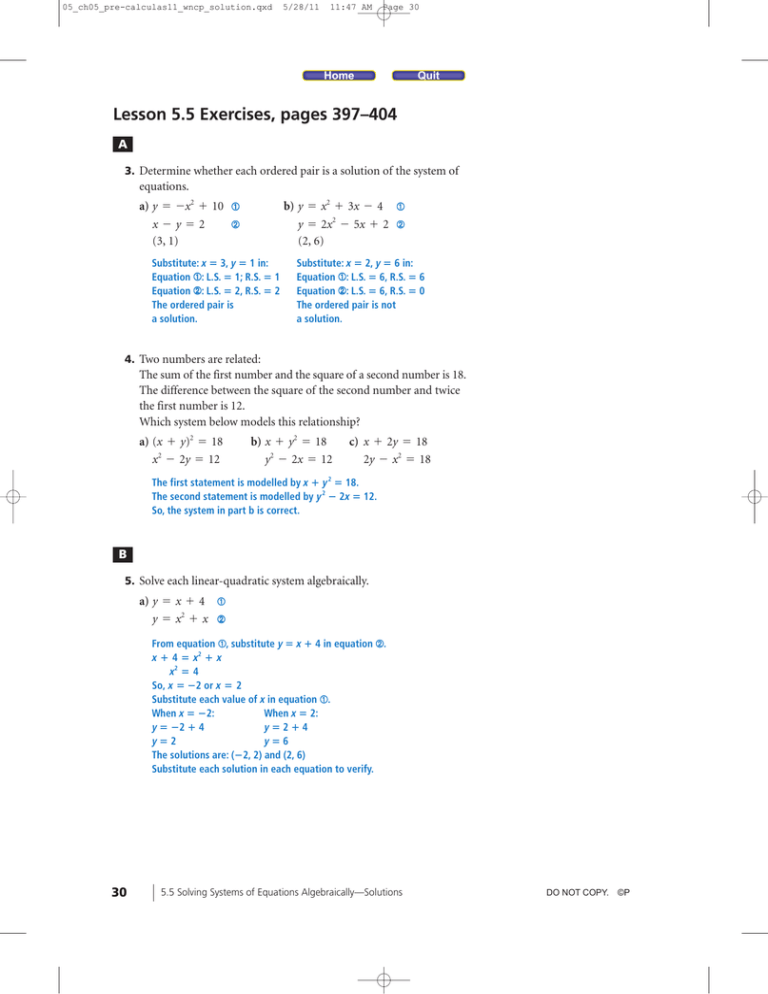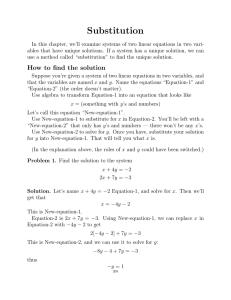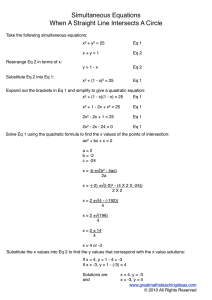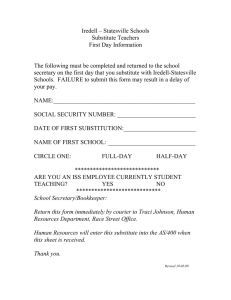Lesson 5.5 Exercises, pages 397–404
advertisement

05_ch05_pre-calculas11_wncp_solution.qxd 5/28/11 11:47 AM Page 30 Home Quit Lesson 5.5 Exercises, pages 397–404 A 3. Determine whether each ordered pair is a solution of the system of equations. a) y = - x2 + 10 ➀ ➁ x - y = 2 (3, 1) b) y = x2 + 3x - 4 ➀ y = 2x2 - 5x + 2 ➁ (2, 6) Substitute: x ⴝ 3, y ⴝ 1 in: Equation ➀: L.S. ⴝ 1; R.S. ⴝ 1 Equation ➁: L.S. ⴝ 2, R.S. ⴝ 2 The ordered pair is a solution. Substitute: x ⴝ 2, y ⴝ 6 in: Equation ➀: L.S. ⴝ 6, R.S. ⴝ 6 Equation ➁: L.S. ⴝ 6, R.S. ⴝ 0 The ordered pair is not a solution. 4. Two numbers are related: The sum of the first number and the square of a second number is 18. The difference between the square of the second number and twice the first number is 12. Which system below models this relationship? a) (x + y)2 = 18 x2 - 2y = 12 b) x + y2 = 18 y2 - 2x = 12 c) x + 2y = 18 2y - x2 = 18 The first statement is modelled by x ⴙ y 2 ⴝ 18. The second statement is modelled by y 2 ⴚ 2x ⴝ 12. So, the system in part b is correct. B 5. Solve each linear-quadratic system algebraically. a) y = x + 4 ➀ y = x2 + x ➁ From equation ➀, substitute y ⴝ x ⴙ 4 in equation ➁. x ⴙ 4 ⴝ x2 ⴙ x x2 ⴝ 4 So, x ⴝ ⴚ2 or x ⴝ 2 Substitute each value of x in equation ➀. When x ⴝ ⴚ2: When x ⴝ 2: y ⴝ ⴚ2 ⴙ 4 yⴝ2ⴙ4 yⴝ2 yⴝ6 The solutions are: (ⴚ2, 2) and (2, 6) Substitute each solution in each equation to verify. 30 5.5 Solving Systems of Equations Algebraically—Solutions DO NOT COPY. ©P 05_ch05_pre-calculas11_wncp_solution.qxd 5/28/11 11:47 AM Page 31 Home Quit b) y = -x + 5 ➀ y = (x + 1)2 ➁ From equation ➀, substitute y ⴝ ⴚx ⴙ 5 in equation ➁. ⴚx ⴙ 5 ⴝ (x ⴙ 1)2 ⴚx ⴙ 5 ⴝ x2 ⴙ 2x ⴙ 1 2 x ⴙ 3x ⴚ 4 ⴝ 0 (x ⴙ 4)(x ⴚ 1) ⴝ 0 So, x ⴝ ⴚ4 or x ⴝ 1 Substitute each value of x in equation ➀. When x ⴝ ⴚ4: When x ⴝ 1: y ⴝ ⴚ(ⴚ4) ⴙ 5 y ⴝ ⴚ1 ⴙ 5 yⴝ9 yⴝ4 The solutions are: (ⴚ4, 9) and (1, 4) Substitute each solution in each equation to verify. ➀ c) y = 3x - 2 2 y = x + 4x - 2 ➁ From equation ➀, substitute y ⴝ 3x ⴚ 2 in equation ➁. 3x ⴚ 2 ⴝ x2 ⴙ 4x ⴚ 2 x2 ⴙ x ⴝ 0 x(x ⴙ 1) ⴝ 0 So, x ⴝ 0 or x ⴝ ⴚ1 Substitute each value of x in equation ➀. When x ⴝ 0: When x ⴝ ⴚ1: y ⴝ 3(0) ⴚ 2 y ⴝ 3(ⴚ1) ⴚ 2 y ⴝ ⴚ2 y ⴝ ⴚ5 The solutions are: (0, ⴚ2) and (ⴚ1, ⴚ5) Substitute each solution in each equation to verify. 6. Two numbers are related: The first number minus 12 is equal to the second number. The square of the first number minus 30 times the second number is equal to 360. a) Create a system of equations to represent this relationship. Let the numbers be represented by x and y respectively. A system is: ➀ x ⴚ 12 ⴝ y x2 ⴚ 30y ⴝ 360 ➁ ©P DO NOT COPY. 5.5 Solving Systems of Equations Algebraically—Solutions 31 05_ch05_pre-calculas11_wncp_solution.qxd 5/28/11 11:47 AM Page 32 Home Quit b) Solve the system to determine the numbers. From equation ➀, substitute y ⴝ x ⴚ 12 in equation ➁. x2 ⴚ 30(x ⴚ 12) ⴝ 360 x 2 ⴚ 30x ⴝ 0 x(x ⴚ 30) ⴝ 0 So, x ⴝ 0 or x ⴝ 30 Substitute each value of x in equation ➀. When x ⴝ 0: When x ⴝ 30: 0 ⴚ 12 ⴝ y 30 ⴚ 12 ⴝ y y ⴝ ⴚ12 y ⴝ 18 The numbers are: 0 and ⴚ12; or 30 and 18 Substitute each pair of numbers in the problem statements to verify. 7. Solve each quadratic-quadratic system algebraically. Verify each solution using graphing technology. ➀ a) y = x2 + 4 y = -x2 + 12 ➁ From equation ➀, substitute y ⴝ x2 ⴙ 4 in equation ➁. x2 ⴙ 4 ⴝ ⴚx2 ⴙ 12 2x2 ⴝ 8 x2 ⴝ 4 So, x ⴝ ⴚ2 or x ⴝ 2 Substitute each value of x in equation ➀. When x ⴝ ⴚ2: When x ⴝ 2: y ⴝ 22 ⴙ 4 y ⴝ (ⴚ2)2 ⴙ 4 yⴝ8 yⴝ8 The solutions are: (ⴚ2, 8) and (2, 8) b) y = 2(x + 4)2 ➀ 1 y = 2(x + 1)2 ➁ From equation ➀, substitute y ⴝ 2(x ⴙ 4)2 in equation ➁. 1 2 2(x ⴙ 4)2 ⴝ (x ⴙ 1)2 4(x ⴙ 4)2 ⴝ (x ⴙ 1)2 4x ⴙ 32x ⴙ 64 ⴝ x2 ⴙ 2x ⴙ 1 3x2 ⴙ 30x ⴙ 63 ⴝ 0 x2 ⴙ 10x ⴙ 21 ⴝ 0 (x ⴙ 3)(x ⴙ 7) ⴝ 0 So, x ⴝ ⴚ3 or x ⴝ ⴚ7 Substitute each value of x in equation ➀. When x ⴝ ⴚ3: When x ⴝ ⴚ7: y ⴝ 2(ⴚ 7 ⴙ 4)2 y ⴝ 2(ⴚ 3 ⴙ 4)2 yⴝ2 y ⴝ 18 The solutions are: (ⴚ3, 2) and (ⴚ7, 18) 2 32 5.5 Solving Systems of Equations Algebraically—Solutions DO NOT COPY. ©P 05_ch05_pre-calculas11_wncp_solution.qxd 5/28/11 11:47 AM Home Page 33 Quit c) y = 2x2 + 12x + 18 ➀ y = -(x + 3)2 + 12 ➁ From equation ➀, substitute y ⴝ 2x2 ⴙ 12x ⴙ 18 in equation ➁. 2x2 ⴙ 12x ⴙ 18 ⴝ ⴚ(x ⴙ 3)2 ⴙ 12 2x2 ⴙ 12x ⴙ 18 ⴝ ⴚx2 ⴚ 6x ⴚ 9 ⴙ 12 3x2 ⴙ 18x ⴙ 15 ⴝ 0 x2 ⴙ 6x ⴙ 5 ⴝ 0 (x ⴙ 5)(x ⴙ 1) ⴝ 0 So, x ⴝ ⴚ5 or x ⴝ ⴚ1 Substitute each value of x in equation ➀. When x ⴝ ⴚ5: When x ⴝ ⴚ1: y ⴝ 2(ⴚ1)2 ⴙ 12(ⴚ1) ⴙ 18 y ⴝ 2(ⴚ5)2 ⴙ 12(ⴚ5) ⴙ 18 yⴝ8 yⴝ8 The solutions are: (ⴚ5, 8) and (ⴚ1, 8) Substitute each solution in each equation to verify. 8. Solve each linear-quadratic system algebraically. Verify each solution using graphing technology. a) y = -2x2 + 1 ➀ 4x + 3y = 12 ➁ From equation ➀, substitute y ⴝ ⴚ2x2 ⴙ 1 in equation ➁. 4x ⴙ 3(ⴚ2x2 ⴙ 1) ⴝ 12 4x ⴚ 6x2 ⴚ 9 ⴝ 0 6x2 ⴚ 4x ⴙ 9 ⴝ 0 Use the quadratic formula. √ ⴚ b_ b2 ⴚ 4ac xⴝ 2a √ xⴝ 4_ ( ⴚ 4)2 ⴚ 4(6)(9) √ xⴝ Substitute: a ⴝ 6, b ⴝ ⴚ4, c ⴝ 9 2(6) 4_ ⴚ 200 12 Since the discriminant is negative, there are no real solutions. b) y = x2 - 3x + 2 4x - 4y = 7 ➀ ➁ From equation ➀, substitute y ⴝ x2 ⴚ 3x ⴙ 2 in equation ➁. 4x ⴚ 4(x2 ⴚ 3x ⴙ 2) ⴝ 7 4x ⴚ 4x2 ⴙ 12x ⴚ 8 ⴝ 7 4x2 ⴚ 16x ⴙ 15 ⴝ 0 (2x ⴚ 5)(2x ⴚ 3) ⴝ 0 So, x ⴝ 2.5 or x ⴝ 1.5 Substitute each value of x in equation ➀. When x ⴝ 2.5: When x ⴝ 1.5: y ⴝ (1.5)2 ⴚ 3(1.5) ⴙ 2 y ⴝ (2.5)2 ⴚ 3(2.5) ⴙ 2 y ⴝ 0.75 y ⴝ ⴚ0.25 The solutions are: (2.5, 0.75) and (1.5, ⴚ0.25) ©P DO NOT COPY. 5.5 Solving Systems of Equations Algebraically—Solutions 33 05_ch05_pre-calculas11_wncp_solution.qxd 5/28/11 11:47 AM Page 34 Home Quit 9. Solve each quadratic-quadratic system algebraically. Use the quadratic formula when necessary. a) y = 2x2 - 7x + 3 2 y = 3(x - 1)2 + 1 ➀ ➁ From equation ➀, substitute y ⴝ 2x2 ⴚ 7x ⴙ 3 in equation ➁. 2 3 2x2 ⴚ 7x ⴙ 3 ⴝ (x ⴚ 1)2 ⴙ 1 6x2 ⴚ 21x ⴙ 9 ⴝ 2x2 ⴚ 4x ⴙ 2 ⴙ 3 4x2 ⴚ 17x ⴙ 4 ⴝ 0 (x ⴚ 4)(4x ⴚ 1) ⴝ 0 So, x ⴝ 4 or x ⴝ 0.25 Substitute each value of x in equation ➀. When x ⴝ 4: When x ⴝ 0.25: y ⴝ 2(0.25)2 ⴚ 7(0.25) ⴙ 3 y ⴝ 2(4)2 ⴚ 7(4) ⴙ 3 yⴝ7 y ⴝ 1.375 The solutions are: (4, 7) and (0.25, 1.375) b) y = x2 + 8x + 15 ➀ 2 ➁ y = -2x - 16x + 33 From equation ➀, substitute y ⴝ x2 ⴙ 8x ⴙ 15 in equation ➁. x2 ⴙ 8x ⴙ 15 ⴝ ⴚ2x2 ⴚ 16x ⴙ 33 3x ⴙ 24x ⴚ 18 ⴝ 0 x2 ⴙ 8x ⴚ 6 ⴝ 0 Use the quadratic formula. 2 √ xⴝ xⴝ xⴝ ⴚ b_ b2 ⴚ 4ac 2a √ Substitute: a ⴝ 1, b ⴝ 8, c ⴝ ⴚ6 ⴚ 8_ 82 ⴚ 4(1)(ⴚ6) √ 2(1) ⴚ 8_ 88 2 √ x ⴝ ⴚ4_ 22 Substitute each value √ of x in equation ➀. When x ⴝ ⴚ4 ⴙ 22: y ⴝ ( ⴚ4 ⴙ √ 2 √ 22 ) ⴙ 8( ⴚ4 ⴙ 22 ) ⴙ 15 √ √ y ⴝ 16 ⴚ 8 22 ⴙ 22 ⴚ 32 ⴙ 8 22 ⴙ 15 y ⴝ 21 When x ⴝ ⴚ4 ⴚ √ 22: √ √ y ⴝ ( ⴚ4 ⴚ 22 )2 ⴙ 8( ⴚ4 ⴚ 22 ) ⴙ 15 √ √ y ⴝ 16 ⴙ 8 22 ⴙ 22 ⴚ 32 ⴚ 8 22 ⴙ 15 y ⴝ 21 The solutions are: ( ⴚ4 ⴙ 34 √ 22, 21) and ( ⴚ4 ⴚ √ 22, 21) 5.5 Solving Systems of Equations Algebraically—Solutions DO NOT COPY. ©P 05_ch05_pre-calculas11_wncp_solution.qxd 5/28/11 11:47 AM Page 35 Home Quit ➀ c) y = -2(x + 4)2 - 5 2 y = -2x - 16x - 37 ➁ From equation ➀, substitute y ⴝ ⴚ2(x ⴙ 4)2 ⴚ 5 in equation ➁. ⴚ2(x ⴙ 4)2 ⴚ 5 ⴝ ⴚ2x2 ⴚ 16x ⴚ 37 ⴚ2x2 ⴚ 16x ⴚ 37 ⴝ ⴚ2x2 ⴚ 16x ⴚ 37 Since the left side is equal to the right side for all values of x, there are infinite solutions. d) y = x2 + 3x - 2 y = -x2 + 4x - 3 ➀ ➁ From equation ➀, substitute y ⴝ x2 ⴙ 3x ⴚ 2 in equation ➁. x2 ⴙ 3x ⴚ 2 ⴝ ⴚx2 ⴙ 4x ⴚ 3 2x2 ⴚ x ⴙ 1 ⴝ 0 Use the quadratic formula. √ ⴚ b_ b2 ⴚ 4ac xⴝ 2a √ xⴝ xⴝ Substitute: a ⴝ 2, b ⴝ ⴚ1, c ⴝ 1 1_ (ⴚ1) ⴚ 4(2)(1) √ 2 2(1) 1_ ⴚ 7 2 Since the discriminant is negative, there are no real solutions. 10. Two numbers are related in this way: The number 1 is subtracted from the first number, the difference is squared, then doubled; the result is equal to the second number. The number 1 is added to the first number, and the sum is squared; the result is equal to 4 minus the second number. Determine the numbers. Explain the strategy you used. Let the numbers be represented by x and y respectively. A system is: ➀ 2(x ⴚ 1)2 ⴝ y (x ⴙ 1)2 ⴝ 4 ⴚ y ➁ From equation ➀, substitute y ⴝ 2(x ⴚ 1)2 in equation ➁. (x ⴙ 1)2 ⴝ 4 ⴚ 2(x ⴚ 1)2 x2 ⴙ 2x ⴙ 1 ⴝ 4 ⴚ 2x2 ⴙ 4x ⴚ 2 3x2 ⴚ 2x ⴚ 1 ⴝ 0 (x ⴚ 1)(3x ⴙ 1) ⴝ 0 So, x ⴝ 1 or x ⴝ ⴚ 1 3 Substitute each value of x in equation ➀. 1 3 When x ⴝ 1: When x ⴝ ⴚ : 2(1 ⴚ 1)2 ⴝ y 2 aⴚ ⴚ 1b ⴝ y 1 3 yⴝ0 yⴝ 1 3 The numbers are: 1 and 0; or ⴚ and ©P DO NOT COPY. 2 32 9 32 9 5.5 Solving Systems of Equations Algebraically—Solutions 35 05_ch05_pre-calculas11_wncp_solution.qxd 5/28/11 11:47 AM Page 36 Home Quit 11. An emergency flare is propelled into the sky from a spot on the ground. The path of the flare is modelled by the equation y = -0.096(x - 25)2 + 60, where y metres is the height of the flare when its horizontal distance from where it was propelled is x metres. A telescope is placed at the spot from which the flare was propelled. The line of sight from the telescope is modelled by the equation 8x - 10y = -15. a) Solve the system formed by the two equations. Give the answers to the nearest tenth of a unit. y ⴝ ⴚ0.096(x ⴚ 25)2 ⴙ 60 ➀ ➁ 8x ⴚ 10y ⴝ ⴚ15 From equation ➀, substitute y ⴝ ⴚ0.096(x ⴚ 25)2 ⴙ 60 in equation ➁. 8x ⴚ 10(ⴚ0.096(x ⴚ 25)2 ⴙ 60) ⴝ ⴚ15 8x ⴙ 0.96x2 ⴚ 48x ⴙ 600 ⴚ 600 ⴙ 15 ⴝ 0 0.96x2 ⴚ 40x ⴙ 15 ⴝ 0 Use the quadratic formula. √ ⴚ b_ b2 ⴚ 4ac xⴝ 2a √ xⴝ 40_ ( ⴚ 40) ⴚ 4(0.96)(15) √ xⴝ Substitute: a ⴝ 0.96, b ⴝ ⴚ40, c ⴝ 15 2 2(0.96) 40_ 1542.4 1.92 x ⴝ 41.2882. . . or x ⴝ 0.3784. . . Substitute each value of x in equation ➁. When x ⴝ 41.2882. . . 8(41.2882. . .) ⴚ 10y ⴝ ⴚ15 10y ⴝ 345.3058. . . y ⴝ 34.5305. . . When x ⴝ 0.3784. . . 8(0.3784. . .) ⴚ 10y ⴝ ⴚ15 10y ⴝ 18.0274. . . y ⴝ 1.8027. . . The solutions are approximately: (41.3, 34.5) and (0.4, 1.8) b) Explain the meaning of the solution of the system. The flare is seen through the telescope when the flare has travelled approximately 0.4 m horizontally and 1.8 m vertically; and when the flare has travelled approximately 41.3 m horizontally and 34.5 m vertically. 36 5.5 Solving Systems of Equations Algebraically—Solutions DO NOT COPY. ©P 05_ch05_pre-calculas11_wncp_solution.qxd 5/28/11 11:47 AM Home Page 37 Quit C 12. After a football is kicked, it reaches a maximum height of 14 m and it hits the ground 32 m from where it was kicked. After a soccer ball is kicked, it reaches a maximum height of 8 m and it hits the ground 38 m from where it was kicked. The paths of both balls are parabolas. a) Create an equation that represents the path of the football. Let (0, 0) represent the initial position of the ball. Visualize a coordinate grid. Assume the football was on the ground when it was kicked. So, the parabola has x-intercepts of 0 and 32. The x-coordinate of its maximum point is 16, so its vertex has coordinates (16, 14). The equation of the parabola has the form: y ⴝ ax(x ⴚ 32) Substitute: x ⴝ 16, y ⴝ 14 14 ⴝ a(16)(16 ⴚ 32) aⴝⴚ 7 128 An equation is: y ⴝ ⴚ 7 x (x ⴚ 32) 128 b) Create an equation that represents the path of the soccer ball. Let (0, 0) represent the initial position of the ball. Visualize a coordinate grid. Assume the soccer ball was on the ground when it was kicked. So, the parabola has x-intercepts of 0 and 38. The x-coordinate of its maximum point is 19, so its vertex has coordinates (19, 8). The equation of the parabola has the form: y ⴝ ax(x ⴚ 38) Substitute: x ⴝ 19, y ⴝ 8 8 ⴝ a(19)(19 ⴚ 38) aⴝⴚ 8 361 An equation is: y ⴝ ⴚ 8 x (x ⴚ 38) 361 c) To the nearest tenth of a metre, determine the horizontal distance that both balls have travelled when they reach the same height. Solve the system formed by the equations in parts a and b. 7 x (x ⴚ 32) 128 8 yⴝⴚ x (x ⴚ 38) 361 yⴝⴚ ➀ ➁ From equation ➀, substitute y ⴝ ⴚ ⴚ 7 x (x ⴚ 32) in equation ➁. 128 7 8 x (x ⴚ 32) ⴝ ⴚ x (x ⴚ 38) 128 361 361(7)x(x ⴚ 32) ⴝ 128(8)x(x ⴚ 38) 2527x 2 ⴚ 80 864x ⴝ 1024x 2 ⴚ 38 912x x(1503x ⴚ 41 952) ⴝ 0 x ⴝ 0 or x ⴝ 27.9121. . . So, the balls have travelled approximately 27.9 m horizontally when they reach the same height. ©P DO NOT COPY. 5.5 Solving Systems of Equations Algebraically—Solutions 37


